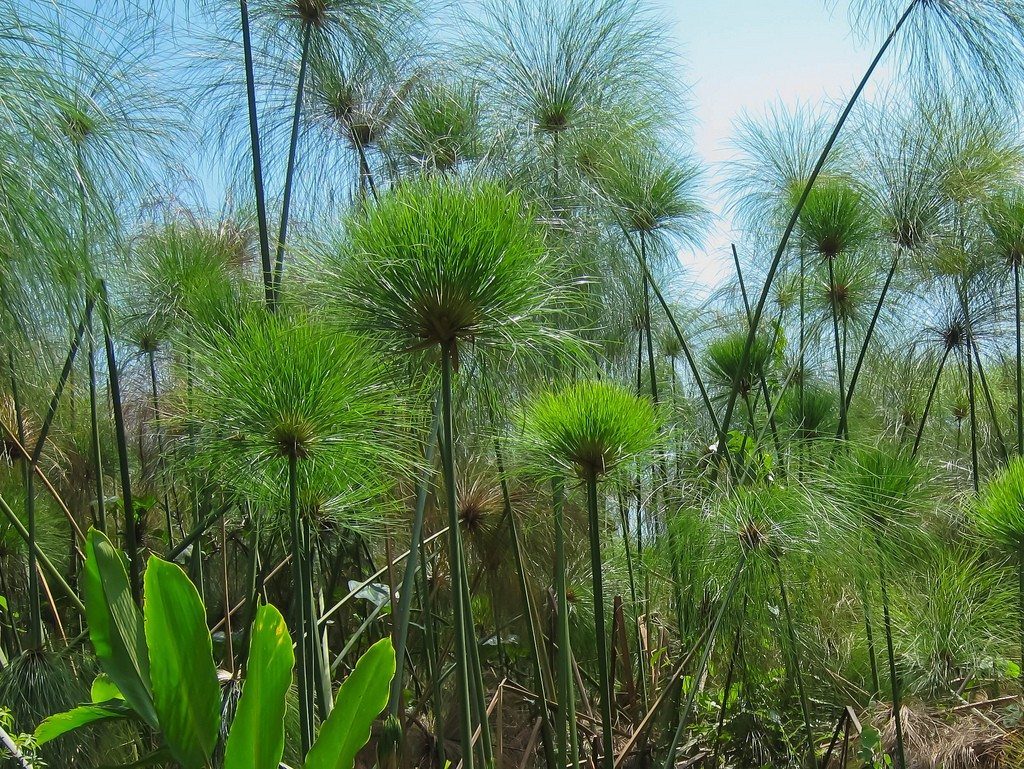Akagera plants provides oxygen, nourishment, shade and shelter for many animals in Akagera National Park. Identifying Akagera plants and trees is not always easy but here is a simple guide that we on how you can get to know Akagera plants existing in the park.
Book Now

Papyrus Plants are some of the Akagera plants to see in Akagera National Park, Rwanda
White Thorn – Acacia Seyal – Akagera plants
There are over 1,300 species of Acacia worldwide. This Akagera plant in particular is indigenous and widely distributed throughout East Africa. It has an irregularly flattened crown that grows to 12m in height, sometimes found in shrubby form. The flowers re round, bright yellow and numerous. The pods are thin around 7-22 cm in length curved and brown when they dry. Traditionally the bark is used medicinally to treat colds and gum to treat stomachache.
Papyrus – Cyperus Papyrus
This Akagera plant is native to tropical regions of Africa and famous for its use by the ancient Egyptian for paper –making. Papyrus grows in water and produces solid triangular –shaped stems of up to 3m. in bloom up to 100 green, thread like filaments appear in a circular arrangement at the end of each stem. There are vast areas of papyrus in the Akagera wetland, clumps of papyrus often break away and drifts down the lakes like giants floating islands. In Akagera plants, Papyrus is home to numerous bird species, to rarities, the shoebill and the papyrus gonolek are found in papayrus wetlands.
Rough Leaved Shepherd’s Tree – Boscia Angustifolia
Distinctive among Akagera plants, looking ever green shrub or tree growing from 0.5-8m. Indigenous to Africa and commonly found in deciduous dry bush land and arid sites such as hills laterite outcrops and cliffs. The leaves are grey-green, hard and leathery with a sharp tip. The berries are edible when cooked and pieces of boiled wood are used to sweeten milk in West Africa. The trunk of tree is often partially hollow and it is well known to provide shelter for swarm of bees.
Carissa-Carissa Spinarum – Akagera plants
A scrambling bush, sometimes found as a spiny evergreen shrub. Indigenous and common throughout East Africa in bush lands and dry forest edges. The pink –white flowers are found in clusters and highly scented. The read –black berries are edible when ripe, the milky sap of the green unripe fruit and of these Akagera plants are poisonous. Traditionally a decoration of the roots is used as a pain killer and to treat malaria. It is also indigenous to Australia and tropical regions around the Indian Ocean where it is commonly known as Conkerberry, Bush plum or Currant Bush. The district of Kayonza, which includes south of Akagera is named after the iminyonza bush.
Ambach –Aeschynomene Elaphrosylon
Ambach, or Nile pith, is a common large shrub or small tree growing up to 9m high. It is indigenous to parts of tropical Africa, typically growing y water or in water –logged soils. It is wide spread along the edges of the lakes in Akagera, particularly Lake Ihema. The stem have spines and tree produces yellow flowers. The wood of the Ambach tree is very fiberous and light –weight. Small crocodiles and monitor lizards often use the lower branches to bask on, and many birds in Akagera use the Ambach to nest in, particularly weaver birds, herons and cormorants around lakes
Red Globe Thistle –Echinops Amplexicalis
Native to East Africa, this wildflower is a perennial herb. It can measure 1-2.5m and stands erect with a spherical flower on the tip, measuring 12cm across. It can be found in altitudes of above 1,000m. In Akagera, they are common along the ridge road from Munyundu to Rwisirabo, flowering early in the year. It has been recorded as a treatment for tape worms in Ethiopia. It was featured on Rwandan stamps in the mid-1960s.
These and more plant life can be found elsewhere in Rwanda including in the famous Volcanoes National Park, a home to the Mountain Gorillas in Rwanda and the golden Monkeys. More unique plant life in Nyungwe Forests well known for tracking chimpanzees in Rwanda and interesting nature walks.
Book Now
